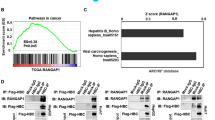Abstract
Hepatitis B virus (HBV) X protein (HBx) is a 17-kDa transcriptional coactivator that plays a significant role in the regulation of genes involved in inflammation and cell survival. It has been known to be involved in the development of liver cancer and alteration of the cellular HBx level may influence the pathogenesis of HBV-induced liver diseases. The transcription factor GLI1, a member of the glioma-associated oncogene homologue (GLI) subfamily of Krüppel-like zinc finger proteins is involved in signal transduction within the hedgehog (Hh) signaling pathway, which is involved in the development of many human malignancies. GLI activation is important for cell proliferation and anti-apoptosis in various cancers. To investigate whether the transcriptional coactivator HBx binds to the zinc finger transcription factor GLI1, recombinant HBx and GLI1 were isolated. Expression and purification of the HBx and GLI1 proteins were successfully performed in Escherichia coli. The binding of HBx to GLI1 was detected by surface plasmon resonance spectroscopy (BIAcore), fluorescence measurement, and a His-tagged pull-down experiment. After measuring the fluorescence emission spectra of purified HBx and GLI1, it was found that the interaction of these proteins is accompanied by significant conformational changes in one or both. This study provides important clues for the structural identification of signal transduction pathways involving the HBx and GLI1 proteins.






Similar content being viewed by others
References
Arbuthnot, P., & Kew, M. (2001). Hepatitis B virus and hepatocellular carcinoma. International Journal of Experimental Pathology, 82(2), 77–100.
Murakami, S. (1999). Hepatitis B virus X protein: structure, function biology. Intervirology, 42(2–3), 82–99.
Murakami, S. (2001). Hepatitis B virus X protein: a multifunctional regulator. Journal of Gastroenterology, 36(10), 651–660.
Shirakata, Y., Kawada, M., Fujiki, Y., Sano, H., Oda, M., Yaginuma, K., et al. (1989). The x gene of hepatitis B virus induced growth stimulation and tumorigenic transformation of mouse NIH3T3 cells. Japanese Journal of Cancer Research, 80(7), 617–621.
Hohne, M., Schaefer, S., Scifer, M., Feitelson, M. A., Paul, D., & Gerlich, W. H. (1990). Malignant transformation of immortalized transgenic hepatocyte after transfection with hepatitis B virus DNA. The EMBO Journal, 9(4), 1137–1145.
Kim, C.-M., Koike, K., Saito, I., Miyamura, T., & Jay, G. (1991). HBx gene of hepatitis B virus induces liver cancer in transgenic mice. Nature, 351(6324), 317–320.
Yu, D. Y., Moon, H. B., Son, J. K., Jeong, S., Yu, S. L., Yoon, H., et al. (1999). Incidence of hepatocellular carcinoma in transgenic mice expressing the hepatitis B virus X-protein. Journal of Hepatology, 31(1), 123–132.
Billet, O., Grimber, G., Levrero, M., Seye, K. A., Briand, P., & Joulin, V. (1995). In vivo activity of the hepatitis B virus core promoter: tissue specificity and temporal regulation. Journal of Virology, 69(9), 5912–5916.
Terradillos, O., Billet, O., Renard, C. A., Levy, R., Molina, T., Briand, P., et al. (1997). The hepatitis B virus X gene potentiates c-myc-induced liver oncogenesis in transgenic mice. Oncogene, 14(4), 395–404.
Madden, C. R., Finegold, M. J., & Slagle, B. L. (2001). Hepatitis B virus X protein acts as a tumor promoter in development of diethylnitrosamine-induced preneoplastic lesions. Journal of Virology, 75(8), 3851–3858.
Su, F., & Schneider, R. J. (1997). Hepatitis B virus HBx protein sensitizes cells to apoptotic killing by tumor necrosis factor alpha. Proceedings of the National Academy of Sciences of the United States of America, 94(16), 8744–8749.
Takada, S., Shirakata, Y., Kaneniwa, N., & Koike, K. (1999). Association of hepatitis B virus X protein with mitochondria causes mitochondrial aggregation at the nuclear periphery, leading to cell death. Oncogene, 18(50), 6965–6973.
Lu, Y. W., & Chen, W. N. (2005). Human hepatitis B virus X protein induces apoptosis in HepG2 cells: role of BH3 domain. Biochemical and Biophysical Research Communications, 338(3), 1551–1556.
Kim, S., Kim, H.-Y., Lee, S., Kim, S. W., Sohn, S., Kim, K., et al. (2007). Hepatitis B virus X protein induces perinuclear mitochondrial clustering in microtubule- and dynein-dependent manners. Journal of Virology, 81(4), 1714–1726.
Ruizi, A. A. (1999). Gli proteins encode context-dependent positive and negative functions: implications for development and disease. Development, 126(14), 3205–3216.
Sasaki, H., Hui, C., Nakafuku, M., & Kondoh, H. (1997). A binding site for Gli proteins is essential for HNF-3beta floor plate enhancer activity in transgenics and can respond to Shh in vitro. Development, 124(7), 1313–1322.
Liu, C. Z., Yang, J. T., Yoon, J. W., Villavicencio, E., Pfendler, K., Walterhouse, D., et al. (1998). Characterization of the promoter region and genomic organization of GLI, a member of the Sonic hedgehog-Patched signaling pathway. Gene, 209(1–2), 1–11.
Callahan, C. A., et al. (2004). MIM/BEG4, a Sonic hedgehog-responsive gene that potentiates Gli-dependent transcription. Genes & Development, 18(22), 2724–2729.
Lo, S. J., Chien, M. L., & Lee, Y. H. (1988). Characteristics of the X gene of hepatitis B virus. Virology, 167(1), 289–292.
Kinzler, K. W., Ruppert, J. M., Bigner, S. H., & Vogelstein, B. (1988). The Gli gene is a member of the Kruppel family of zinc finger proteins. Nature, 332(6162), 371–374.
Kinzler, K. W., & Vogelstein, B. (1990). The Gli gene encodes a nuclear protein which binds specific sequences in the human genome. Molecular and Cellular Biology, 10(2), 634–642.
Gupta, A., Mal, T. K., Jayasuryan, N., & Chauhan, V. S. (1995). Assignment of disulphide bonds in the X protein (HBx) of hepatitis B virus. Biochemical and Biophysical Research Communications, 212(3), 919–924.
Acknowledgements
This study was supported for 2 years by Pusan National University Research Grant.
Author information
Authors and Affiliations
Corresponding author
Rights and permissions
About this article
Cite this article
Jo, B.B., Jeong, M.S., Park, S.Y. et al. The Binding of Hepatitis B Virus X Protein to Glioma-Associated Oncogene Homologue 1 and its Biological Characterization In vitro. Appl Biochem Biotechnol 165, 109–122 (2011). https://doi.org/10.1007/s12010-011-9237-8
Received:
Accepted:
Published:
Issue Date:
DOI: https://doi.org/10.1007/s12010-011-9237-8




